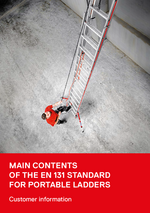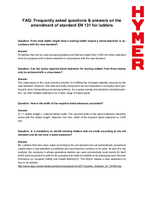EUROPEAN STANDARD EN 131
Quick overview: EN 131 requirements
Are you looking for reliable information on the current ladder standard EN 131? Standards are recognised rules of technology containing specifications for the manufacture and testing of products. The European standard EN 131 applies to portable ladders.
Everything you need to know about the latest EN 131 standard is summarised for you here in a clear and easy-to-understand way. The main requirements for ladders in EN 131-1, EN 131-2, EN 131-3, EN 131-4 can be found here, from stand extensions for leaning ladders to specifications on jointed ladders. Find out more – with HYMER-Steigtechnik.
From what ladder length does a leaning ladder require a stand extension in accordance with the new standard?
All ladders that can be used as leaning ladders and that are longer than 3,000 mm when extended must be equipped with a stand extension in accordance with the new standard.
Can the newly required stand extension for leaning ladders from three metres only be achieved with a cross-beam?
The cross-beam is the most common solution for fulfilling the increased stability required by the new standard. However, this wide and bulky component can be impractical in everyday work (particularly when transporting and storing ladders). As a space-saving and standard-compliant solution, we offer foldable stabilisers for a wide range of ladder types.
How is the width of the required stand extension calculated?
(0.1 × ladder length) + external ladder width. The required width of the stand extension therefore varies with the ladder length. However, the max. width of the required stand extension is 1,200 mm.
Is it mandatory to retrofit existing ladders that are made according to the old standard and do not have a stand extension?
No. Ladders that have been made according to the old standard are not automatically considered unsafe when a new standard is published and may therefore continue to be used. As part of a risk analysis, the company in whose operations ladders are used commercially must decide for itself which work equipment is safe for its purposes and make it available to its employees (see German Ordinance on Industrial Safety and Health BetrSichV). The DGUV makes a clear statement on this on its website:
https://www.dguv.de/de/mediencenter/pm/pressearchiv/2017/quartal_4/details_04_157894.jsp
If a leaning, extension or rope-operated extension ladder is retrofitted with a cross-beam, does it comply with the new standard?
No, because the amendments to EN 131 for ladders do not only affect the stand extension for leaning ladders. In addition to the design-related amendments in Part 1 of the standard, the requirements for the tests described in Part 2 are also affected, to which a ladder must be subjected by the manufacturer before market launch. In addition, new tests (e.g. the anti-slip test on the floor for leaning ladders) have been introduced. Without testing a ladder made according to the old standard, it cannot be guaranteed that it will also meet the new requirements. One cannot automatically derive from this that a ladder retrofitted with a cross-beam also fully complies with the new standard.
Does a ladder that is hooked on but does not have a cross-beam comply with the new standard?
No. Not all ladder types available on the market are clearly covered by EN 131. Hook ladders are not described in the standard and can therefore only partially comply with it (e.g. with regard to load capacity). In practice, however, it can be assumed that there is no risk of tipping over on ladders that are only used hooked on and that a cross-beam is therefore not required for safe use.
Telescopic ladders (height-adjustable articulated ladders) already offer increased stability due to their conical shape. Do they therefore also comply with the new standard without the stand extension?
No. Telescopic ladders are included in Part 4 of the EN 131 ladder standard. This part refers to the amended specifications in Part 1 of the standard with regard to the design features. This means that the following applies according to the current status: Only a telescopic ladder with stand extension can also comply with the new standard. However, wide cross-beams are rather impractical in everyday work, which is why our telescopic ladders with folding stabilisers offer increased stability.
How can I tell whether a ladder is suitable for private or commercial use?
An innovation in Part 3 of EN 131 is the division of ladders into two classes:
- ladders for professional use (professional)
- ladders for non-professional use (private)
Depending on the ladder class, the product must be tested by the manufacturer according to different test requirements, e.g. in the durability test for step ladders:
- 50,000 load cycles for ladders for professional use
- 10,000 load cycles for ladders for non-professional use
The standard provides a clear description of the mandatory labelling for ladders:
- Ladder for professional use
- Ladder for non-professional use

Is the commercial user only allowed to use ladders of the ladder class for professional use?
The decision as to which ladder class the commercial user chooses for his equipment is left to the contractor as part of a risk assessment. Due to the higher loads in the commercial environment, however, the exclusive use of professional ladders is expressly recommended.
Can retailers continue to sell ladders that they still stock according to the old standard?
Yes. The amendments to the standard are generally not relevant for trade. Ladders built according to the old standard are not automatically considered unsafe when the new standard is published and therefore remain legally compliant even after the amendment to the standard. The stock according to the old standard can therefore be sold by the retailers without hesitation.
How can you tell whether a ladder has been manufactured in accordance with the latest standard?
The manufacturer must state on the product label according to which standard he has manufactured the ladder. If no date of issue of the standard is stated on the product label, the ladder must always comply with the latest version of the standard.
Can new ladders still be put on the market by the manufacturer after the cut-off date of the standard changeover (01/01/2018), even if they do not comply with EN 131?
In principle, products that do not comply with an existing standard may also be marketed. However, the manufacturer is responsible for the safety of these products and must ensure that there is no risk to the user in the event of so-called "foreseeable misuse". That means specifically: Leaning ladders over three metres in length without a stand extension may be marketed, provided that it is ensured that the user is clearly aware of the extent to which they can guarantee safe use of the ladder (e.g. by fixing the ladder) and obtain all parts required for this from the manufacturer (e.g. suspension hook). However, if the product description and equipment are designed in such a way that they are also aimed at users who simply dispense with the required stand extension and do not want to fix the ladder, the manufacturer is exposed to a considerable liability risk.






